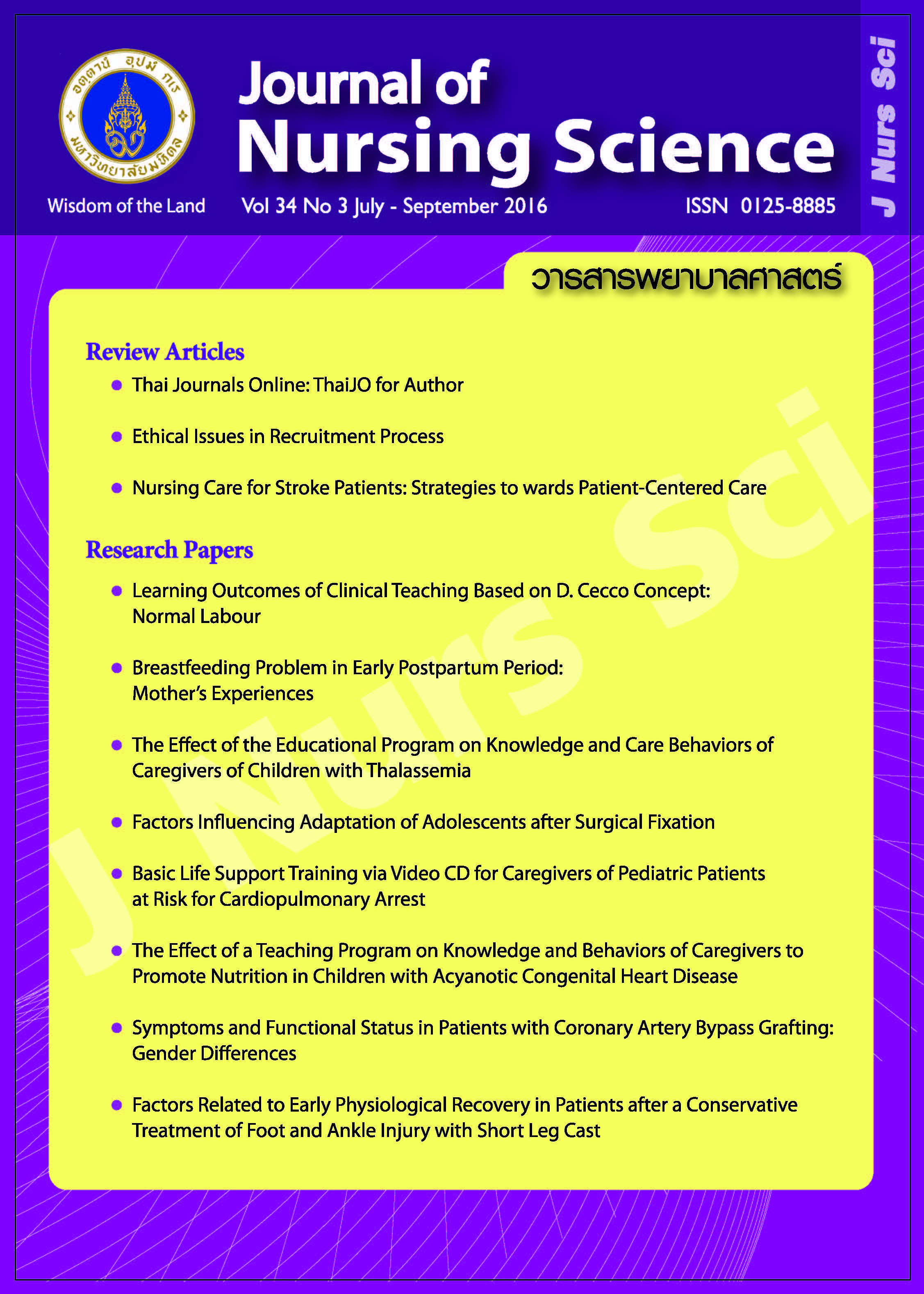The Effect of the Educational Program on Knowledge and Care Behaviors of Caregivers of Children with Thalassemia
Main Article Content
Abstract
Abstract
Purpose: To examine the effect of the educational program for decreasing iron accumulation on knowledge and care behaviors of caregivers of preschool-age children with thalassemia.
Design: Quasi-experimental design.
Methods: The sample included caregivers who took their children to attend the Pediatric Hematology Clinic, Department of Pediatrics in a tertiary university hospital. The sample was divided into the experimental and the control group, with 15 subjects in each group. Caregivers in
the experimental group received the educational program while caregivers in the control group received routine care. Data were collected using the iron overload knowledge questionnaire and care behaviors of caregivers for decreasing iron accumulation in preschool-age children with thalassemia questionnaire. Data were analyzed by ANCOVA.
Main findings: The results showed that caregivers in the experimental group had a higher mean score of knowledge after the educational program than those in the control group [F (2, 27) = 15.26, p < .05]. Similarly, caregivers in the experimental group had a higher mean score of care behaviors after the educational program than those in the control group [F (2, 27) = 55.54, p < .05].
Conclusion and recommendations: This study suggests that the educational program is effective in increasing knowledge and care behavior of the caregivers of children with thalassemia. Thus, this program could be implemented as a tool to assist the caregivers in providing better care to decrease iron accumulation in preschool aged children with thalassemia.
ผลของโปรแกรมการสอนต่อความรู้และพฤติกรรมการดูแลของผู้ดูแลผู้ป่วยเด็กโรคธาลัสซีเมีย
บทคัดย่อ
วัตถุประสงค์: เพื่อศึกษาผลของโปรแกรมการสอนเพื่อชะลอการสะสมเหล็กในร่างกายของผู้ป่วยเด็กวัยก่อนเรียนโรคธาลัสซีเมีย
รูปแบบการวิจัย: การวิจัยกึ่งทดลอง
วิธีดำเนินการวิจัย: กลุ่มตัวอย่าง คือ ผู้ดูแลที่พาผู้ป่วยเด็กวัยก่อนเรียนโรคธาลัสซีเมียมารับการรักษาที่คลินิกโลหิตวิทยาเด็กในโรงพยาบาลมหาวิทยาลัยแห่งหนึ่งในกรุงเทพมหานคร แบ่งเป็นกลุ่มควบคุมและกลุ่มทดลอง กลุ่มละ 15 ราย กลุ่มทดลองได้รับโปรแกรมการสอน ส่วนกลุ่มควบคุมได้รับการพยาบาลตามปกติ เก็บรวบรวมข้อมูลโดยใช้แบบสอบถามความรู้เรื่องภาวะเหล็กเกิน และพฤติกรรมการดูแลของผู้ดูแลเพื่อชะลอการสะสมเหล็กในร่างกายของผู้ป่วยเด็กวัยก่อนเรียนโรคธาลัสซีเมีย วิเคราะห์ข้อมูลโดยใช้สถิติวิเคราะห์ความแปรปรวนร่วม
ผลการวิจัย: ผู้ดูแลกลุ่มที่ได้รับโปรแกรมการสอน มีค่าเฉลี่ยคะแนนความรู้ภายหลังได้รับโปรแกรมการสอนสูงกว่าผู้ดูแลกลุ่มที่ได้รับการพยาบาลตามปกติ ภายหลังจากที่ควบคุมตัวแปรร่วม คือ คะแนนความรู้ก่อนได้รับโปรแกรมการสอน อย่างมีนัยสำคัญทางสถิติ [F (2, 27) = 15.26, p < .05] และผู้ดูแลกลุ่มที่ได้รับโปรแกรมการสอน มีค่าเฉลี่ยคะแนนพฤติกรรมการดูแลสูงกว่าผู้ดูแลกลุ่มที่ได้รับการพยาบาลตามปกติ ภายหลังจากที่ควบคุมตัวแปรร่วม คือ คะแนนพฤติกรรมการดูแล อย่างมีนัยสำคัญทางสถิติ [F (2, 27) = 55.54, p < .05]
สรุปและข้อเสนอแนะ: โปรแกรมการสอนนี้มีประสิทธิภาพในการส่งเสริมให้ผู้ดูแลผู้ป่วยเด็กวัยก่อนเรียนโรคธาลัสซีเมีย มีความรู้และพฤติกรรมที่ดีขึ้น ดังนั้นสามารถนำโปรแกรมการสอนไปใช้ในผู้ดูแลเพื่อการชะลอการสะสมเหล็กในร่างกายผู้ป่วยเด็กวัยก่อนเรียนโรคธาลัสซีเมีย
คำสำคัญ: พฤติกรรม โปรแกรมการสอน ผู้ดูแล การสะสมเหล็กในร่างกาย เด็กวัยก่อนเรียน โรคธาลัสซีเมีย
Article Details
Copyright Notice: Nursing Science Journal of Thailand has exclusive rights to publish and distribute the manuscript and all contents therein. Without the journal’s permission, the dissemination of the manuscript in another journal or online, and the reproduction of the manuscript for non-educational purpose are prohibited.

Disclaimer: The opinion expressed and figures provided in this journal, NSJT, are the sole responsibility of the authors. The editorial board bears no responsibility in this regard.


